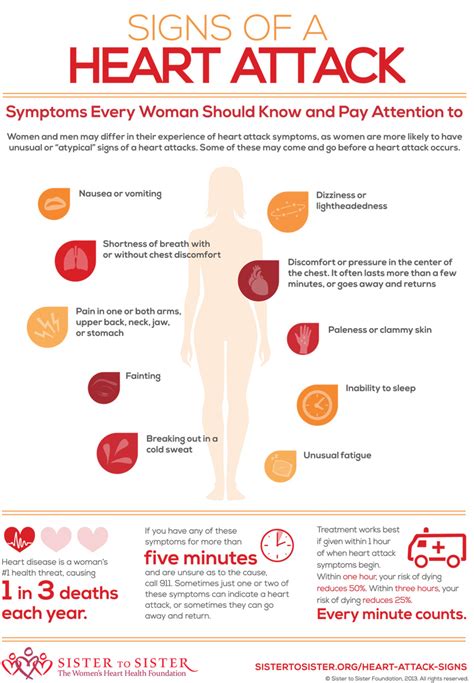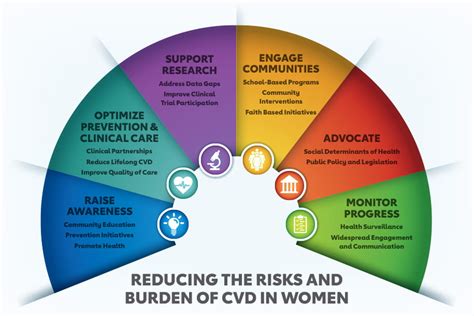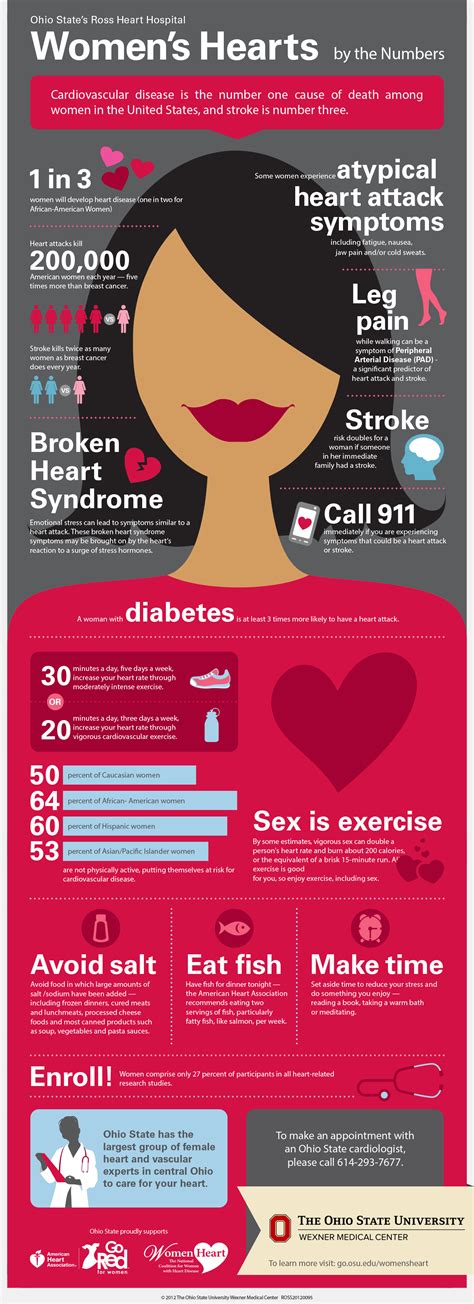Intro
Learn heart attack symptoms in women, including chest pain, shortness of breath, and nausea, to recognize warning signs and prevent cardiac arrest, arrhythmia, and coronary artery disease.
Heart attacks are a leading cause of death worldwide, and they can affect anyone, regardless of age or gender. While heart attack symptoms in men are well-documented, women often experience different symptoms, which can make diagnosis more challenging. It is essential to understand the unique symptoms of heart attacks in women to provide timely and effective treatment.
Heart disease is the number one killer of women in the United States, accounting for one in every five deaths. Despite this, many women are unaware of the risks and symptoms of heart attacks. A survey conducted by the American Heart Association found that only 54% of women knew that heart disease was the leading cause of death among women. This lack of awareness can lead to delayed diagnosis and treatment, resulting in poorer outcomes.
The importance of recognizing heart attack symptoms in women cannot be overstated. Women are more likely to experience silent heart attacks, which can be just as deadly as traditional heart attacks. Silent heart attacks occur when the heart muscle is damaged due to a lack of blood flow, but there are no noticeable symptoms. This highlights the need for women to be aware of their risk factors and to take proactive steps to reduce their likelihood of experiencing a heart attack.
Understanding Heart Attack Symptoms in Women

Heart attack symptoms in women can vary, but there are some common signs to look out for. These include chest pain or discomfort, shortness of breath, pain or discomfort in the arms, back, neck, jaw, or stomach, feeling weak, lightheaded, or faint, and cold sweats. Women may also experience other symptoms, such as nausea or vomiting, fatigue, and pain or discomfort in the teeth or jaw.
Risk Factors for Heart Attacks in Women
Certain risk factors can increase a woman's likelihood of experiencing a heart attack. These include high blood pressure, high cholesterol, smoking, obesity, physical inactivity, diabetes, and a family history of heart disease. Women who have had a previous heart attack or have been diagnosed with coronary artery disease are also at a higher risk.Diagnosing Heart Attacks in Women

Diagnosing heart attacks in women can be more challenging than in men due to the different symptoms they experience. Healthcare providers use a combination of medical history, physical examination, and diagnostic tests to diagnose heart attacks. These tests may include electrocardiograms (ECGs), blood tests, and imaging tests such as echocardiograms or coronary angiograms.
Treatment Options for Heart Attacks in Women
Treatment for heart attacks in women typically involves a combination of medications and procedures. Medications may include aspirin, beta blockers, and nitroglycerin, while procedures may include angioplasty, stenting, or coronary artery bypass grafting (CABG). Women who have experienced a heart attack may also be prescribed medications to reduce their risk of future heart attacks, such as statins or blood thinners.Preventing Heart Attacks in Women

Preventing heart attacks in women involves reducing risk factors and adopting a healthy lifestyle. This can include eating a healthy diet, exercising regularly, maintaining a healthy weight, and not smoking. Women should also work with their healthcare provider to manage any underlying medical conditions, such as high blood pressure or diabetes.
Lifestyle Changes to Reduce Heart Attack Risk
Making lifestyle changes can significantly reduce a woman's risk of experiencing a heart attack. These changes may include: * Eating a healthy diet that is low in saturated and trans fats, added sugars, and sodium * Engaging in regular physical activity, such as walking or other aerobic exercises * Maintaining a healthy weight through a combination of diet and exercise * Not smoking and avoiding secondhand smoke * Managing stress through techniques such as meditation or deep breathingRecognizing the Signs of a Heart Attack

Recognizing the signs of a heart attack is crucial for prompt treatment and improved outcomes. Women should be aware of the common symptoms of heart attacks, including chest pain or discomfort, shortness of breath, and pain or discomfort in the arms, back, neck, jaw, or stomach. If these symptoms occur, women should call emergency services immediately and seek medical attention.
What to Do in Case of a Heart Attack
If a woman experiences symptoms of a heart attack, she should: * Call emergency services immediately * Chew an aspirin, if prescribed by a healthcare provider * Stay calm and try to remain still * Avoid driving herself to the hospital * Provide medical history and symptoms to emergency respondersSupport and Resources for Women with Heart Disease

Women with heart disease can benefit from support and resources to manage their condition and reduce their risk of future heart attacks. These resources may include:
- Support groups, either in-person or online
- Educational materials and websites
- Healthcare providers who specialize in women's heart health
- Medications and treatments to manage symptoms and reduce risk
Importance of Community Support
Community support can play a vital role in helping women manage heart disease and reduce their risk of future heart attacks. This support may come from family and friends, support groups, or online communities. Women should not be afraid to reach out for help and support, as it can significantly improve their outcomes and quality of life.Current Research and Developments in Women's Heart Health

Current research and developments in women's heart health are focused on improving diagnosis, treatment, and prevention of heart attacks in women. This research includes studies on the unique symptoms and risk factors of heart attacks in women, as well as the development of new medications and treatments. Women can stay up-to-date on the latest research and developments by following reputable health organizations and websites.
Future Directions in Women's Heart Health
Future directions in women's heart health will likely focus on personalized medicine, where treatment is tailored to an individual woman's unique needs and risk factors. This may involve genetic testing, biomarkers, and other advanced technologies to improve diagnosis and treatment. Additionally, there will be a growing emphasis on prevention and lifestyle changes to reduce the risk of heart attacks in women.What are the most common symptoms of a heart attack in women?
+The most common symptoms of a heart attack in women include chest pain or discomfort, shortness of breath, and pain or discomfort in the arms, back, neck, jaw, or stomach.
How can women reduce their risk of heart attacks?
+Women can reduce their risk of heart attacks by eating a healthy diet, exercising regularly, maintaining a healthy weight, not smoking, and managing underlying medical conditions such as high blood pressure or diabetes.
What should women do if they experience symptoms of a heart attack?
+If women experience symptoms of a heart attack, they should call emergency services immediately, chew an aspirin if prescribed, and stay calm and still until help arrives.
Are there any support groups or resources available for women with heart disease?
+Yes, there are many support groups and resources available for women with heart disease, including online communities, educational materials, and healthcare providers who specialize in women's heart health.
What is the current research focused on in women's heart health?
+Current research in women's heart health is focused on improving diagnosis, treatment, and prevention of heart attacks in women, including studies on unique symptoms and risk factors, as well as the development of new medications and treatments.
In conclusion, heart attack symptoms in women can be different from those experienced by men, making diagnosis and treatment more challenging. However, by understanding the unique symptoms and risk factors, women can take proactive steps to reduce their likelihood of experiencing a heart attack. We encourage readers to share this article with friends and family to help raise awareness about women's heart health. If you have any questions or comments, please do not hesitate to reach out. Together, we can work towards improving the health and well-being of women everywhere.
